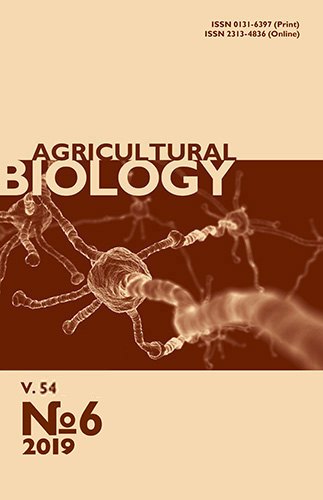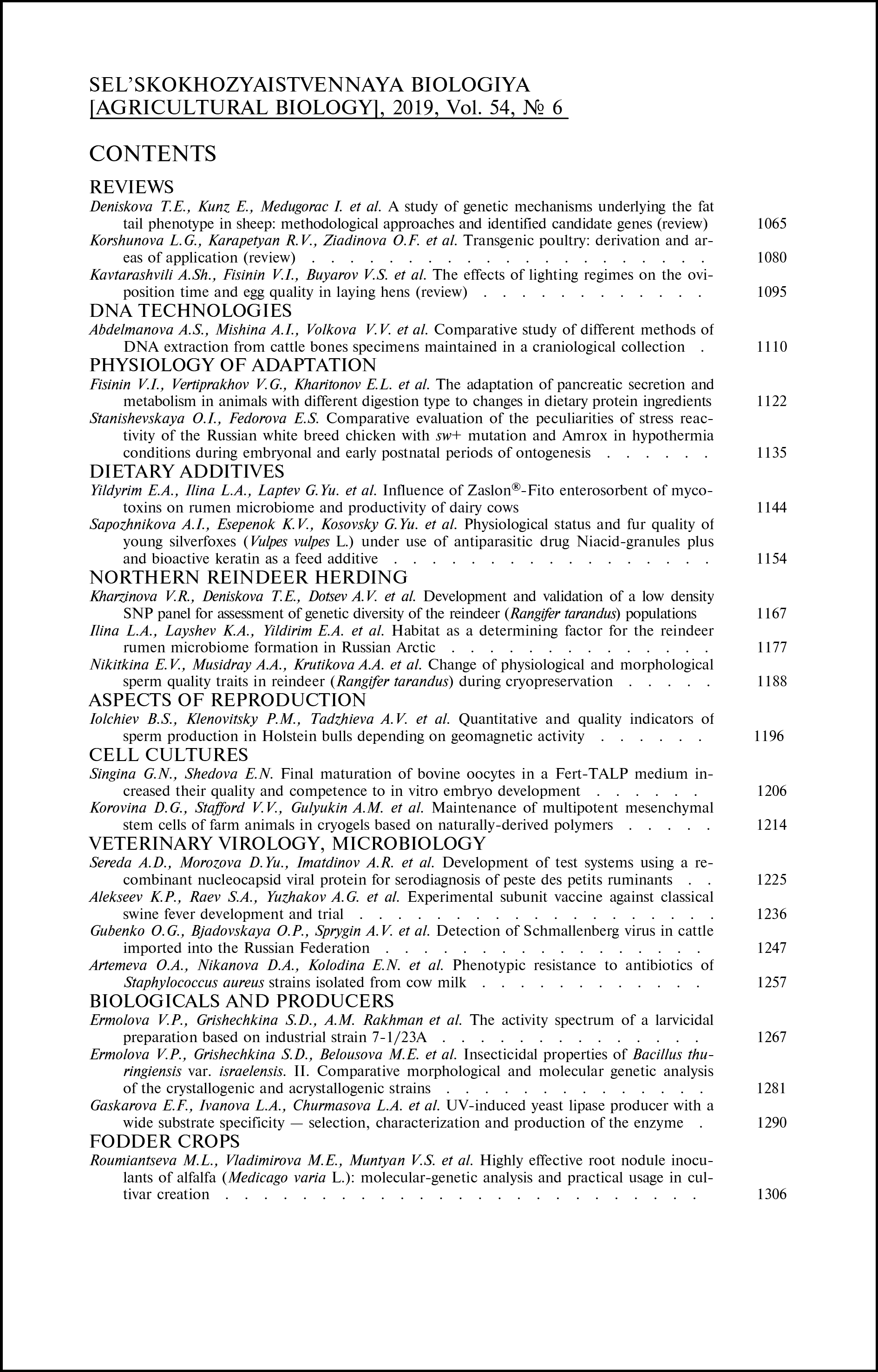doi: 10.15389/agrobiology.2019.6.1290eng
UDC: 579.6:577.15
Acknowledgements:
The authors are grateful to the staff of the State Research Institute of Genetics and Breeding of Industrial Microorganisms of the National Research Center Kurchatov Institute (GosNIIgenetika) and personally to Prof. S.P. Sineokii, the Director of the All-Russian Collection of Industrial Microorganisms of the GosNIIgenetika.
The work was carried out within the project № 0710-2017-0010 “Search for living systems and substances of natural origin with an analysis of their biological activity for the creation of functional food and feed”.
UV-INDUCED YEAST LIPASE PRODUCER WITH A WIDE SUBSTRATE SPECIFICITY – SELECTION, CHARACTERIZATION AND PRODUCTION OF THE ENZYME
E.F. Gaskarova, L.A. Ivanova, L.A. Churmasova, N.G. Mashentseva, D.L. Klabukova
Moscow State University of Food Industry, 11, Volokolamskoe sh., Moscow, 125080 Russia, e-mail biotech@mgupp.ru, ludmila-churmasova@yandex.ru, natali-mng@yandex.ru (✉ corresponding author), daria.klabukova@yandex.ru
ORCID:
Gaskarova E.F. orcid.org/0000-0002-4775-4913
Mashentseva N.G. orcid.org/0000-0002-9287-0585
Ivanova L.A. orcid.org/0000-0002-9506-0043
Klabukova D.L. orcid.org/0000-0002-5621-5700
Churmasova L.A. orcid.org/0000-0002-1285-1799
Received September 6, 2019
Lipases are capable of changing the quantitative and/or qualitative characteristics of fat-containing raw materials and widely used for various tasks in modern food and agricultural industries. To meet the growing demand for these enzymes, highly effective producers are needed, especially those exhibiting multiple activity to lipids of different structure and origin. The aim of the study was to search for a new yeast strain with high production of lipase with broad substrate specificity, and to optimize its fermentation conditions. This work objectives also included obtaining an enzyme with a high grade of hydrolysis of various oils, and the study of its technological properties. Lipolytic characteristics were studied in 110 yeast isolates obtained from natural sources and the collections of Moscow State University of Food Production and State Research Institute of Genetics and Selection of Industrial Microorganisms. Qualitative assay of lipase activity was carried out using a differential nutrient medium with tributyrin and dye methyl red; quantitative analysis was carried out in accordance with the modified Y. Ota & K. Yamada method at pH 5.5. Of the 23 strains with lipolytic activity (LA), 12 had sufficiently high LA indices from 2.5 to 7.5 U/cm3, of which M10 isolate with maximum activity was selected. For this isolate, morphological, cultural, physiological and biochemical properties were studied and molecular genetic identification was performed. The strain was identified as Candida parapsilosis (99 % of homology) using phylogenetic analysis and deposited in the All-Russian Collection of Industrial Microorganisms under the number Y-4055. After UV mutagenesis, a highly active mutant C. parapsilosis M10-10 was obtained. Using mathematical planning methods, the optimal nutrient medium for its growth and lipase production was determined as, %: mustard oil — 2.6, yeast extract — 1.8, soy flour — 1, glucose — 0.5, Tween 80 — 0.42, CaCO3 — 0.3, KH2PO4 — 0.03, MgSO4·7H2O — 0.02. An enzyme with a purification grade of 20× and lipolytic activity of 30630 U/g was obtained after culturing the strain M10-10 at a 30-40 °С temperature and pH of the nutrient medium 5.5-6.5. It was found that by 48 hours of fermentation, lipase reaches the highest activity in the culture medium when inoculum M10-10 is in an amount of 5%. Optimal conditions for the enzyme were determined as 37 °С and pH 5.5. In terms of activity, the resulting product is not inferior to commercial domestic and foreign enzymes, including Novozym 435 (Sigma-Aldrich, USA) with a lipolytic activity of 24020 U/g. The fatty acid specificity of the new lipase was determined by enzymatic treatment of various vegetable oils and gas chromatography of lipid products using a Shimadzu GC 2010 (Shimadzu, Japan). Modification of vegetable oils with M10-10 lipase in an oil/water emulsion significantly reduced 2.4, 4.6, 2.9 and 1.5 times the saturated fatty acids fraction (including palmitic and stearic acids) and increased 1.5, 1.6, 1.1 and 12 times the polyunsaturated fatty acids fraction (including w-3 linolenic and w-6 linoleic acids) for olive, mustard, sunflower and coconut oils, respectively.
Keywords: Candida parapsilosis M10-10, lipase producer, enzyme preparation, UV mutagenesis, fermentation conditions, lipolytic activity, vegetable oils, modification, saturated fatty acids, unsaturated fatty acids.
REFERENCES
- Ipatova L.V., Kochetkova A.A., Nechaev A.P., Tutel'yan V.A. Zhirovye produkty dlya zdorovogo pitaniya. Sovremennyi vzglyad [Fatty foods for a healthy diet. Modern look]. Moscow, 2009 (in Russ.).
- Raveendran S., Parameswaran B., Ummalyma S.B., Abraham A., Mathew A.K., Madhavan A., Rebello S., Pandey A. Applications of microbial enzymes in food industry. Food Technology and Biotechnology, 2018, 56(1): 16-30 CrossRef
- Tutel'yan V.A., Nechaev A.P. Pishchevye ingredienty v sozdanii sovremennykh produktov pitaniya [Food ingredients in the creation of modern food]. Moscow, 2014 (in Russ.).
- Benjamin S., Pandey A. Isolation and characterization of three distinct forms of lipases from Candida rugosa produced in solid state fermentation. Brazilian Archives of Biology and Technology, 2001, 44(2): 213-221 CrossRef
- Olempska-Beer Z.S., Merker R.I., Ditto M.D., DiNovi M.J. Food-processing enzymes from recombinant microorganisms — a review. Regulatory Toxicology and Pharmacology, 2006, 45(2): 144-158 CrossRef
- Hasan F., Shah A.A., Hameed A. Industrial applications of microbial lipases. Enzyme and Microbial Technology, 2006, 39: 235-251 CrossRef
- Lipase market — global forecast to 2020. Available: https://www.marketsandmarkets.com/Market-Reports/lipase-market-205981206.html. Accessed 15.06.2019.
- Jooyandeh H., Kaur A., Minhas K.S. Lipases in dairy industry: a review. Journal of Food Science and Technology-Mysore, 2009, 46(3): 181-189.
- Houde A., Kademi A., Leblank D. Lipases and their industrial applications. Appl. Biochem. Biotechnol., 2004, 118(1-3): 155-170 CrossRef
- Collins Y.F., McSweeney P.L., Wilkinson M.G. Evidence of a relationship between autolysis of starter bacteria and lipolysis in cheddar cheese during ripening. Journal of Dairy Research, 2003, 70(1): 105-113 CrossRef
- Guerrand D. Lipases industrial applications: focus on food and agroindustries. Oilseeds and fats, Crops and Lipids, 2017, 24(4): D403 CrossRef
- Sharma R., Chisti Y., Banerjee U.C. Production, purification, characterization, and applications of lipases. Biotechnology Advances, 2001, 19(8): 627-662 CrossRef
- Gracheva I.M., Krivova A.Yu. Tekhnologiya fermentnykh preparatov [Enzyme technology]. Moscow, 2000 (in Russ.).
- Shukla P., Gupta K. Ecological screening for lipolytic molds and process optimization for lipase production Rhizopus oryzae KG-5. Journal of Applied Sciences in Environmental Sanitation, 2007, 2(2): 35-42.
- Sambrook J., Russell D.W. Molecular cloning: a laboratory manual. Cold Spring Harbor Laboratory Press, NY, 2001.
- Naumova E.S., Serpova E.V., Naumov G.I. Biokhimiya, 2007, 72(12): 1659-1667 (in Russ.).
- Esteve-Zarzoso V., Belloch C., Uruburu F., Querol A. Identification of yeasts by RFLP analysis of the 5.8S rDNA gene and two ribosomal internal transcribed spacers. International Journal of Systematic Bacteriology, 1999, 49(1): 329-337 CrossRef
- Polygalina G.V., Cherednichenko B.C., Rimareva L.V. Opredelenie aktivnosti fermentov [Determination of enzyme activity]. Moscow, 2003 (in Russ.).
- Ottavei B.P. Obogashchenie pishchevykh produktov i biologicheski aktivnye dobavki [Food fortification and dietary supplements]. Moscow, 2010 (in Russ.).
- Kuhn D.M., Mikherjee P.K., Clark T.A., Pujol C., Chandra J., Hajjeh R.A., Warnock D.W., Soil D.R., Ghannoum M.A. Candida parapsilosis characterization in an outbreak setting. Emerging Infectious Diseases, 2004, 10(6): 1074-1081 CrossRef
- Ivanova L.A., Voino L.I., Ivanova I.S. Pishchevaya biotekhnologiya. Kniga 2. Pererabotka rastitel'nogo syr'ya /Pod redsktsiei I.M. Grachevoi [Food biotechnology. Vol. 2. Processing of plant materials. I.M. Grachevaya (ed.)]. Moscow, 2008 (in Russ.).
- Treichel H., de Oliveira D., Mazutti M.A., di Luccio M., Oliveira J.V. A review on microbial lipases production. Food Bioprocess Technol., 2010, 3(2): 182-196 CrossRef
- Maldonado R.R., Macedo G.A., Rodrigues M.I. Lipase production using microorganism from different agro-industrial by-product. International Journal of Applied Science and Technology, 2014, 4: 108-115.
- Darvishi F., Nahvi I., Zarkesh-Esfahani H., MomenbeikF. Effect of plant oils upon lipase and citric acid production in Yarrowia lipolytica yeast. Journal of Biomedicine and Biotechnology, 2009, 2009: article ID 562943 CrossRef
- Lakshmi B.S., Kangueane P., Abraham B., Pennathur G. Effect of vegetable oils in the secretion of lipase from Candida rugosa (DSM 2031). Letters in Applied Microbiology, 1999; 29: 66-70 CrossRef
- Fickers P., Nicaud J.M., Gaillardin C., Destain J., Thonart P. Carbon and nitrogen sources modulate lipase production in the yeast Yarrowia lipolytica. Journal of Applied Microbiology, 2004, 96(4): 742-749 CrossRef
- Vargas G.D.L.P., Treichel H., de Oliveira D., Beneti S.C., Freire D.M.G., Di Luccio M. Optimization of lipase production by Penicillium simplicissimum in soybean meal. J. Chem. Technol. Biotechnol., 2008, 83(1): 47-54 CrossRef
- Dobrev G., Strinska H., Zhekova B., Dobreva V., Delchev N. Influence of the fermentation medium composition on lipase production by Rhizopus arrhizus. Bulgarian Journal of Agricultural Science, 2014, 20 (Suppl.1): 42-45.
- Chen J., Shimura S., Kirimura K., Usami S. Enhancement of lipase production from hydrocarbons by mutation of Trichosporon fermentans. Appl. Microbiol. Biotechnol., 1993, 38(6): 714-718 CrossRef
- Sandana Mala JG, Kamini NR, Puvanakrishnan R. Strain improvement of Aspergillus niger for enhanced lipase production. The Journal of General and Applied Microbiology, 2001, 47(4): 181-186 CrossRef
- Pignède G., Wang H., Fudalej F., Gaillardin C., Seman M., Nicaud J.M. Characterization of an extracellular lipase encoded by LIP2 in Yarrowia lipolytica. Journal of Bacteriology, 2000, 182(10): 2802-2810 CrossRef
- Darvishi F. Expression of native and mutant extracellular lipases from Yarrowia lipolytica in Saccharomyces cerevisiae. Microbial Biotechnology, 2012, 5(5): 634-641 CrossRef
- Yuzbasheva E.Yu., Yuzbashev T.V., Gordeeva T.L., Laptev I.A., Vybornaya T.V., Sineokii S.P. Shtamm drozhzhei Yarrowia lipolytica — produtsent kletochno-svyazannoilipazy. Patent RF № RU 2475532 C1. Zayavl. 09.02.2012. Opubl. 20.02.2013. Byul. № 5 [Yarrowia lipolytica Yarrowia lipolytica — producer of cell-bound lipase. Patent RF № RU 2475532 C1. Appl. 09.02.2012. Publ. 20.02.2013. Bul. № 5] (in Russ.).
- Dayton C.L.G., Galhardo F. Enzymatic degumming utilizing a mixture of PLA and PLC phospholipases. Patents US № US20080182322A1. Priority date 2007-01-30. Pub. Date 2008-07-31.
- Ciafardini G., Zullo B.A. Virgin olive oil yeasts: a review. Food Microbiology, 2018, 70: 245-253 CrossRef
- Gupta R., Kumari A., Syal P., Singh Y. Molecular and functional diversity of yeast and fungal lipases: their role in biotechnology and cellular physiology. Progress in Lipid Research, 2015, 57: 40-54 CrossRef
- Faber K. Biotransformations in organic chemistry: a textbook. Springer Int. Publ., 2018 CrossRef
- Tanino T., Aoki T., Chung W.Y., Watanabe Y., Ogino C., Fukuda H., Kondo A. Improvement of a Candida antarctica lipase B-displaying yeast whole-cell biocatalyst and its application to the polyester synthesis reaction. Appl. Microbiol. Biotechnol., 2009, 82(1): 59-66 CrossRef
- Su G.D., Zhang X., Lin Y. Surface display of active lipase in Pichia pastoris using Sed1 as an anchor protein. Biotechnol. Lett., 2010, 32(8): 1131-1136 CrossRef
- Madzak C., Gaillardin C., Beckerich J.M. Heterologous protein expression and secretion in the non-conventional yeast Yarrowia lipolytica: a review. Journal of Biotechnology, 2004, 109(1-2): 63-81 CrossRef
- Liu W.S., Pan X.X., Jia B., Zhao H.Y., Xu L., Liu Y., Yan Y.J. Surface display of active lipases Lip7 and Lip8 from Yarrowial ipolytica on Saccharomyces cerevisiae. Appl. Microbiol. Biotechnol, 2010, 88: 885-891 CrossRef
- Gopinath S.C.B., Hilda A., Lakshmi priya T., Annadurai G., Anbu P. Purification of lipase from Geotrichum candidum: conditions optimized for enzyme production using Box-Behnken design. World Journal of Microbiology and Biotechnology, 2003, 19(7): 681-689 CrossRef
- Ciafardini G., Zullo B.A., Iride A. Lipase production by yeasts from extra virgin olive oil. Food Microbiology, 2006, 23(1): 60-67 CrossRef
- Böer E., Mock H.P., Bode R., Gellissen G., Kunze G. An extracellular lipase from the dimorphic yeast Arxula adeninivorans: molecular cloning of the ALIP1 gene and characterization of the purified recombinant enzyme. Yeast, 2005, 22(7): 523-535 CrossRef
- Akoh C.C., Lee G.C., Shaw J.F. Protein engineering and applications of Candida rugosa lipase isoforms. Lipids, 2004, 39: 513-526 CrossRef












